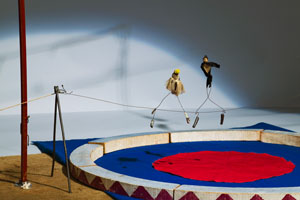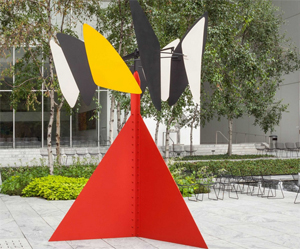When Sculpture Cannot Sit Still
John Haberin New York City
Alexander Calder: Mobiles and a Return to MoMA
I could have caught Alexander Calder at his most static up the Hudson. The Arch could almost serve as an entrance to Storm King Art Center's five hundred acres. Then again, I could have stopped by the Whitney in search of an icon of American sculpture. Calder's Circus might be entertaining real and overgrown children as much as ever. There and with Calder mobiles, he created sculpture so lively that one can use it to introduce Modernism to kids.
Still, the stubborn child in me has always had a question: when are they going to move? The answer at last is now, as the Whitney looks back to Paris and the origins of a new art form. Four years later, after a pandemic, it may have you asking what you long for most in crisis. Is it normalcy, to break the silence in the air, or the extraordinary, to break the silence in your heart? How about both, with a return to Calder at MoMA. 
Business as usual is not often a compliment when it comes to art, not least when it comes to Calder. He is a fixture of urban plazas and museums, with big red sculptures of gentle arcs and solid steel planes. He is the artist of Calder's Circus, which seemed destined never to leave the lobby gallery at the old Whitney museum. With both, he gets to have it both ways, as majestic but playful. Hey, someone had to define the face of public art, and someone had to create mobiles before they became the stuff of childhood parties. This may not be the greatest or most challenging show on earth, but it keeps things in motion.
Not that everything is predictable. A work stands in the Modern's sculpture garden for the very first time. Half a dozen large sculptures stand together as never before. MoMA hardly cares whether you prefer them to the mobiles, though they land with an unexpected impact. It is out to place Calder in the museum's own history—and to give pride of place to them both in a history of modern art. Here normalcy means just that.
Mobiles in motion
With "Hypermobility," the Whitney sets the mobiles in motion. One can see them as Alexander Calder intended—often for the first time since an initial display long ago. One can see, too, their central place in his art. Did his larger, static public sculpture introduce Modernism to corporate adults? When he hit on a back-formation, stabiles, to describe that work, he was reminding everyone what came first. So what if, by its very definition, it is already slipping away?
One really can use the mobiles to introduce sculpture to kids. They show that abstract art, too, gets to play around. The most familiar have the lightness of slim steel planes in black or fire-engine red, suspended by wire like a fancy chandelier on the verge of falling apart. Some incorporate imagery, such as fish, but all are teeming with life. One can take for granted that they do not even have to move, because of their potential for motion. It helps, though, to plan around the museum's schedule, for when they do.
They move in more ways than one. The very first, starting in 1931, incorporate a hidden motor, and restoration took some doing. The show's title suggests hyperactivity, but the changes are often barely perceptible, as a single ball rises while another just as slowly falls. Sculpture moves, but it demands that viewers slow down. Others respond to currents of ambient air, while still others require a museum staffer to give them a push, with a rod. Calder's ingenuity or his early training as an engineer allows them to hold together during their not so simple harmonic motion.
Calder can seem a bit of a lightweight, but he started out heavier. The show holds just three dozen works, most from the Calder Foundation, with a stabile or two outside on the museum's terraces. Double Cat from 1930, in carved wood, still lies face down on the floor, like a "primitive" totem that has come to ruin or taken a nap. The first mobiles make use of wood, too, along with motors and steel. One from 1941 looks like a boulder sprouting modern art. Only after World War II, with the artist approaching fifty, do they reach for the ceiling.
They also reflect his first encounters with abstraction. Their birth coincided with Calder's Paris years—the subject of a larger show at the Whitney in 2009. Background planes make some look almost like paintings, perhaps of constellations. The curators, Jay Sanders with Greta Hartenstein and Melinda Lang, throw in a few static bronze spirals as well, to point to their affinity with modern sculpture. He got to know Fernand Léger and Piet Mondrian, whom he urged to experiment with motion as well. He kept returning, though, to the perpetual motion machine of New York City.
Marcel Duchamp himself coined the term mobile, with a pun on the French for motive, which makes sense. They not only move, but also derive their impetus from within. They also encourage the motives of others, like the staffer with a pole. In concerts during the show's run, musicians and sound artists like Christian Marclay can use them as settings, themes, or instruments. They may still feel caught between clumsiness and lightness, like Calder's Circus. Yet they refuse to sit still—at least until you leave for MoMA.
Playfully majestic
For sure, there has been no shortage of Alexander Calder—not after those shows of his Paris years and mobiles at the Whitney. For the opening at MoMA, the sculpture garden stood almost empty apart from him, Auguste Rodin, and a thirty-six foot tall rose by Isa Genzken. (One could almost imagine that the museum built the garden around Rodin, as if he had made his home in midtown the century before.) The galleries lacked for visitors, but a Calder mobile still descended a staircase just outside the show. They might seem tailor-made for art after Covid-19. When President Biden raised hopes for normalcy on the Fourth of July, he spoke just days before the opening, and Biden's promise may yet become true by its summer closing.
MoMA stresses Calder's place in its own business as usual, too, when it titles the show "Modern from the Start." His work first appeared there in 1930, soon after the building's opening, and he contributed a ten-part candelabrum to the celebratory dinner for a tenth-anniversary show of "Art in Our Time." He made Lobster Trap and Fish Tail for that stairwell on commission in 1939, and he became the youngest artist ever with a MoMA retrospective, at age forty-five in 1943. The show now is just the latest in a series devoted to works from the collection by single artists like Constantin Brancusi and Dorothea Lange. It does borrow fourteen works from the estate, but then Calder himself made a significant museum donation long ago. Feel free to think that you have seen it all many times before.
 Still, the museum argues otherwise. It wants to place him in his time, before World War II, although he lived until 1976. It also wants to rescue him from whimsical or overblown. It picks him up after the most obviously hacked and handmade in wood, and it all but ends with his midcareer retrospective. Not a single work is solid red. He is at his most familiar with the arced planes of the show's first room, where every single floor sculpture is painted black. One can see why titles refer to a monster, a spider, a torpedo, and, in the sculpture garden, a man-eater—black, black, black, and black.
Still, the museum argues otherwise. It wants to place him in his time, before World War II, although he lived until 1976. It also wants to rescue him from whimsical or overblown. It picks him up after the most obviously hacked and handmade in wood, and it all but ends with his midcareer retrospective. Not a single work is solid red. He is at his most familiar with the arced planes of the show's first room, where every single floor sculpture is painted black. One can see why titles refer to a monster, a spider, a torpedo, and, in the sculpture garden, a man-eater—black, black, black, and black.
The show is out, too, to balance his impulses toward the playful and the majestic. The garden sculpture does, by literally balancing a colorful mobile atop a stable base. The torpedo is Dancing Torpedo Shape. The candelabrum sure sounds like crowd-pleasing, like his dalliance with jewelry and cutlery, but it has a long and lumbering presence, also in black. For the curators, Cara Manes with Zuna Maza and Makayla Bailey, the work shows a lifelong commitment to explore volume, motion, and space. The stabiles in red and black set the tone for breakthroughs by David Smith and Mark di Suvero as well.
The quintessentially American artist spent his formative years in Paris—where Léger taught him all about volume, Duchamp about experimentation, and Jean Arp about curves. He also learned to value detail, craft, and skill. The show opens with Calder at his most playful, with sketches in white on a black wall, but the appearance of chalk is an illusion. Rather, the entrance enlarges and reverses a sketch in preparation for his midcareer retrospective, which he oversaw. The opening room includes maquettes along with the larger black sculpture, but even then he is welding steel. Who needs paper, cardboard, and assistants when Calder can do the job right?
The room also includes a mobile of white steel flecks, as Snowflakes. Even here, though, he has figured out how to bring together two dozen wires, like a preposterous array of clothes hangers, so that they turn slowly but surely from vibrations of the air. A passageway takes Calder back to Paris, with what amount to double portraits, in wire and still more vivid shadows on the wall. One is of Josephine Baker, the singer—an entertainer, sure, but also an activist dear to the avant-garde. The second room wraps things up with his introduction to abstraction by Mondrian and his work for MoMA. It is still business as usual, but it is the business of modern art.

Alexander Calder mobiles ran at The Whitney Museum of American Art through October 23, 2017, Calder at The Museum of Modern Art through August 7, 2021. Related reviews cover Calder in Paris and a literally striking Calder mobile.




